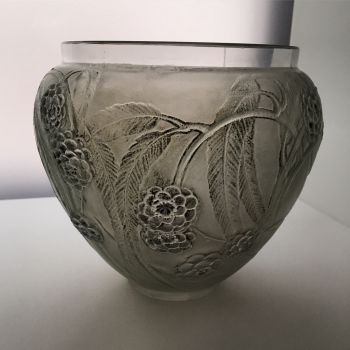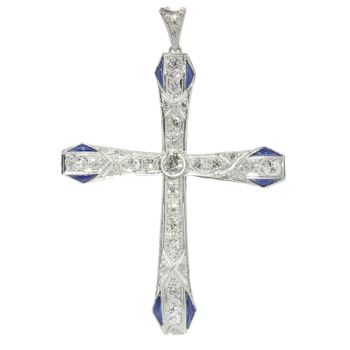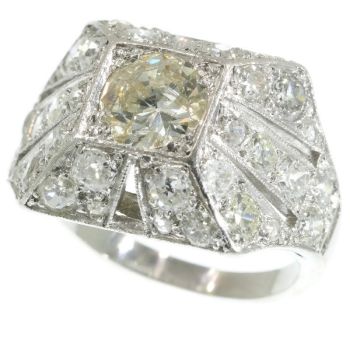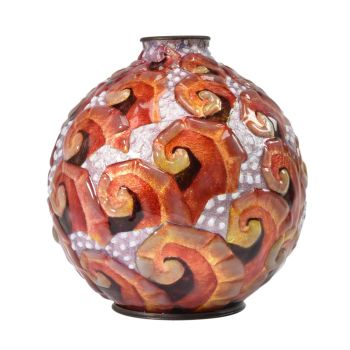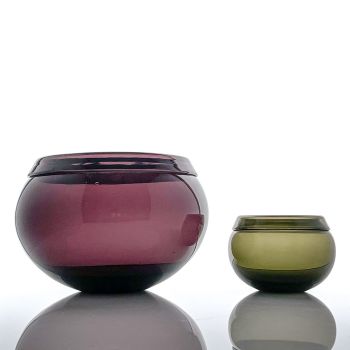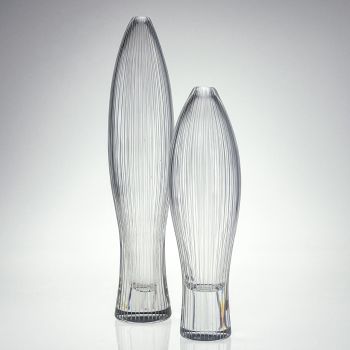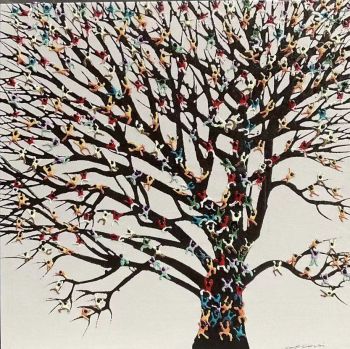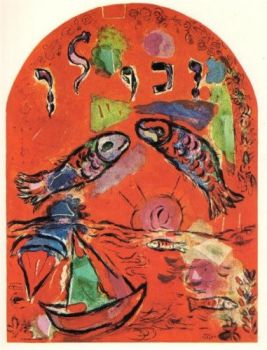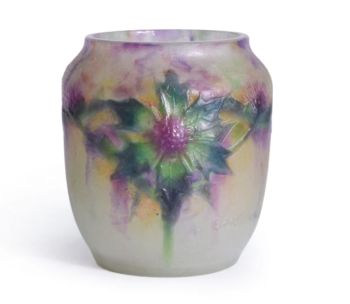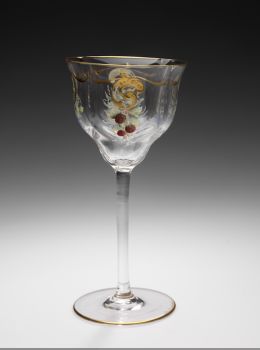Small vase 'Oléron' or 'Petits poissons' 1928 - 1932
René Lalique
Glas
9 cm
ConditionExcellent
Prijs op aanvraag
Dille Art
- Over kunstwerkAbout this piece
Spherical vase with numerous small fish, the vase is called 'Oléron' but is also called 'Petits poissons'.
The vase is extremely refined and beautifully made, it is executed in opalescent glass. The glass consists of multiple layers of opalescent and transparent glass on top of each other, this can be clearly seen at the neck, like the rings of a tree, you see a kind of rings that differ in colour intensity, those are the different layers of glass, (cased opalescent glass), it is a difficult technique. The vase still has very light traces of a patina, so it has had a patina. Through use and especially through cleaning the vase, the infamous annual scrub, the patina has been lost almost completely. In itself, this is not a problem at all because it was an addition to the design. Lalique originally made and sold the vase with and without patina. It just depended on the preference of the buyer. To achieve opalescent glass, a special alloy is needed, everyone had their own secret recipe. René Lalique used, in addition to the usual ingredients such as silicon dioxide or sodium, arsenic, which was banned after the war, and real gold, to increase the colour intensity. Opalescent glass has the special property that it appears bluish/white when backlit, and when light shines on the vase, the glass gets an intense golden glow, as if the sun is shining on it. Very beautiful. The first photo was taken while the vase was placed in front of the window with the sun shining outside. The rather distracting background has been removed, but nothing has been done or altered to the vase itself.
The vase is blown into the mould. It is a design by René Lalique from 1927 and has model number 1008. It was listed in the catalogue of 1928 and 1932.
The vase is signed on the underside with: 'R. Lalique, France, No. 1008'. This signature is applied with the wheel (molette). This way of signing, with the addition 'France' and the model number, was only used between 1928-1932. After 1932, the model number was omitted. According to literature, this was also only done with objects that were blown into the mould, very occasionally an object was still signed in this way if the pressed signature was not clear.
At some point, in the early 1930s, René Lalique, partly due to the crisis, decided to no longer produce designs with labour-intensive finishes. This vase was also part of that decision, and it is therefore no longer mentioned in the 1937 catalogue.
The Municipal Museum of The Hague also has an opal Oléron vase in its collection. - Over kunstenaar
René Jules Lalique (6 april 1860, Ay, Marne - 1 mei 1945, Parijs) geboren op 6 april 1860 in Ay, Marne.
Hij was een Franse glasontwerper die bekend stond om zijn creaties van glaskunst, parfumflesjes, vazen, juwelen, kroonluchters, klokken en autokapversieringen.
In 1872, toen hij twaalf was, trad hij toe tot het Collège Turgot waar hij begon te tekenen en te schetsen. Hij volgde avondlessen aan de Ecole des arts décoratifs. Hij werkte daar van 1874-1876 en bracht vervolgens twee jaar door in de Crystal Palace School of Art Sydenham, Londen. Aan het Sydenham Art College werden zijn vaardigheden voor grafisch ontwerp verbeterd en werd zijn naturalistische benadering van kunst verder ontwikkeld.
Toen hij terugkeerde uit Engeland, werkte hij als freelance kunstenaar en ontwierp hij juwelen voor de Franse juweliers Cartier, Boucheron en anderen.
In 1885 opende hij zijn eigen zaak en ontwierp en maakte hij zijn eigen sieraden en andere glasstukken. In 1890 werd Lalique erkend als een van de belangrijkste Franse juweelontwerpers van de Art Nouveau; hij ontwierp innovatieve stukken voor de nieuwe Parijse winkel van Samuel Bing, Maison de l'Art Nouveau. Hij werd een van de beroemdste in zijn vakgebied, zijn naam staat synoniem voor creativiteit, schoonheid en kwaliteit.
Lalique was het meest bekend om zijn creaties in de glaskunst. In de jaren twintig van de vorige eeuw werd hij bekend om zijn werk in Art Deco stijl. Hij was verantwoordelijk voor de muren van verlicht glas en elegante gekleurde glazen zuilen die de eetzaal en "grand salon" van de SS Normandie vulden en het interieur van de St. Mattheuskerk in Millbrook in Jersey (Lalique's "Glass Church"). Zijn eerdere ervaringen in Ay waren zijn bepalende invloed in zijn latere werk. Het resultaat is dat veel van zijn sieraden en vazen planten, bloemen en vloeiende lijnen laten zien.
Zowel unieke als commerciële werken van René Lalique bevinden zich in de collecties van een groot aantal openbare musea over de hele wereld, waaronder het Museu Calouste Gulbenkian in Lissabon, het Musée Lalique en het Musée des Arts Décoratifs in Frankrijk, het Schmuckmuseum Pforzheim in Duitsland, het Victoria and Albert Museum in Londen, het Metropolitan Museum en het Corning Museum in de staat New York, en het Rijksmuseum in Amsterdam.
René Lalique overleed op 1 mei 1945 in Parijs.
Bent u geïnteresseerd om dit kunstwerk te kopen?
Artwork details
Related artworks
René Lalique
Um vaso "Fougeres" verde profundo muito raro projetado por R. Lalique1912
€ 8.950Lennart Booij Fine Art and Rare Items
 Com curadoria de
Com curadoria deSilla Scheepens
1 - 4 / 12- 1 - 4 / 24
Johann Loetz (Lötz) Witwe Klostermühle
Johann Loetz Witwe - Phänomen Genre 7773 – Orange1900 - 1910
Preço em pedidoAntiques Emporium
Frères Daum
Daum Nancy – “Paysage Soleil Couchant” vase with two applied handles1900 - 1910
Preço em pedidoAntiques Emporium
Gabriel Argy-Rousseau
Gabriël Argy-Rousseau – Crabes et Algues vase – 19201920 - 1929
Preço em pedidoAntiques Emporium
1 - 4 / 24- 1 - 4 / 24
- 1 - 4 / 24
Artista Desconhecido
Japanese art deco lacquervase with Scarab beetle motif1920 - 1950
Preço em pedidoDille Art
1 - 4 / 12







